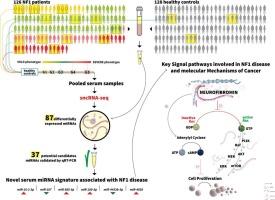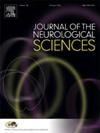血清mirna作为神经纤维瘤病的生物标志物:新的有希望的发现
IF 3.2
3区 医学
Q1 CLINICAL NEUROLOGY
引用次数: 0
摘要
目的1型神经纤维瘤病(NF1)是一种由NF1基因显性突变引起的神经皮肤遗传疾病,其特点是良性和恶性肿瘤易感性增加。NF1突变的类型、基因修饰因子的表达以及表观遗传因素与临床异质性相关。在这方面,microRNAs (miRNAs)在转录后基因调控中发挥作用。令人信服的证据表明,循环mirna反映了病理生理状况,因此成为人类疾病的潜在生物标志物。迄今为止,循环mirna在NF1中的作用研究甚少。我们的目的是研究血清miRNA谱分析作为NF1疾病的新型非侵入性诊断和预后生物标志物。方法采用小片段非编码RNA测序池法和定量反转录PCR验证分析方法,对126例NF1患者的循环mirna进行分析。结果对合并的血清样本进行sncrna -seq分析,发现NF1患者与健康对照组相比有87种差异表达的mirna。qRT-PCR验证证实了NF1中独特的循环miRNA特征,miR-100-5p、miR-16-2-3p、miR-4508和miR-885-5p显著上调,miR-107和miR-4433b-5p下调。基于这六个mirna的分层聚类有效地区分了NF1受试者和对照组,网络分析显示它们参与关键的癌症相关通路,包括ERK/MAPK, PI3K/AKT和mTOR信号传导。我们的研究确定了六种不同的循环miRNA特征,可以可靠地区分NF1患者和未受影响的个体。这些mirna参与调节NF1下游通路和参与肿瘤发生的信号过程。本文章由计算机程序翻译,如有差异,请以英文原文为准。

Serum miRNAs as biomarkers in Neurofibromatosis 1: New promising findings
Objective
Neurofibromatosis type 1 (NF1) is a neurocutaneous genetic disorder caused by dominant mutations in the NF1 gene and characterized by increased susceptibility to develop benign and malignant tumors. The type of NF1 mutation, the expression of gene modifiers as well as epigenetic factors correlate with the clinical heterogeneity. In this regard microRNAs (miRNAs) play a role in post-transcriptional gene regulation. Compelling evidence shows that circulating miRNAs mirror pathophysiological conditions, thus emerging as potential biomarkers for human diseases. To date, the role of circulating miRNAs in NF1 has been poorly investigated. We aimed to study serum miRNA profiling as novel non-invasive diagnostic and prognostic biomarkers for NF1 disease.
Methods
The profile of circulating miRNAs in a monocentric cohort of 126 NF1 patients was carried out by a pooling approach of small non-coding RNA sequencing and validation analysis by Quantitative Reverse Transcription PCR.
Results
sncRNA-seq analysis of pooled serum samples identified 87 differentially expressed miRNAs in NF1 patients compared to healthy controls. qRT-PCR validation confirmed a distinctive circulating miRNA signature in NF1, with significant upregulation of miR-100-5p, miR-16-2-3p, miR-4508, and miR-885-5p and downregulation of miR-107 and miR-4433b-5p. Hierarchical clustering based on these six miRNAs effectively discriminated NF1 subjects from controls, and network analysis revealed their involvement in key cancer-related pathways, including ERK/MAPK, PI3K/AKT, and mTOR signaling.
Interpretation
Our study identified a distinct circulating miRNA signature of six miRNAs that reliably differentiates NF1 patients from non-affected individuals. These miRNAs are implicated in regulating NF1 downstream pathways and signaling processes involved in tumorigenesis.
求助全文
通过发布文献求助,成功后即可免费获取论文全文。
去求助
来源期刊

Journal of the Neurological Sciences
医学-临床神经学
CiteScore
7.60
自引率
2.30%
发文量
313
审稿时长
22 days
期刊介绍:
The Journal of the Neurological Sciences provides a medium for the prompt publication of original articles in neurology and neuroscience from around the world. JNS places special emphasis on articles that: 1) provide guidance to clinicians around the world (Best Practices, Global Neurology); 2) report cutting-edge science related to neurology (Basic and Translational Sciences); 3) educate readers about relevant and practical clinical outcomes in neurology (Outcomes Research); and 4) summarize or editorialize the current state of the literature (Reviews, Commentaries, and Editorials).
JNS accepts most types of manuscripts for consideration including original research papers, short communications, reviews, book reviews, letters to the Editor, opinions and editorials. Topics considered will be from neurology-related fields that are of interest to practicing physicians around the world. Examples include neuromuscular diseases, demyelination, atrophies, dementia, neoplasms, infections, epilepsies, disturbances of consciousness, stroke and cerebral circulation, growth and development, plasticity and intermediary metabolism.
 求助内容:
求助内容: 应助结果提醒方式:
应助结果提醒方式:


